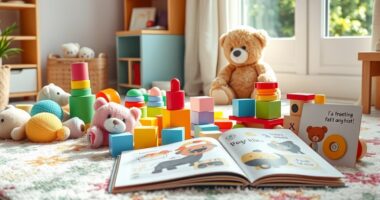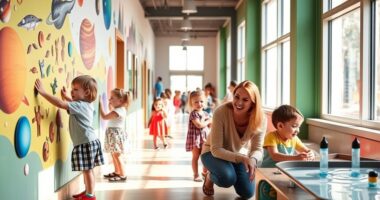Engaging your toddler in arts and crafts activities can greatly boost their creativity and cognitive development. These activities enhance problem-solving skills, fine motor skills, and help express complex emotions. By exploring various materials and techniques, your little one can improve their self-esteem and social skills through teamwork. Plus, unstructured play encourages independent thinking. If you’re curious about fun activities to get started, there’s plenty more to discover that can benefit your child’s creative journey.
Key Takeaways
- Engage toddlers in finger painting to explore colors and enhance cognitive skills through creative expression.
- Incorporate nature-themed crafts, like leaf collages, to connect art with the environment and stimulate artistic imagination.
- Introduce basic stitching or bead threading to improve fine motor skills while fostering creativity and dexterity.
- Encourage unstructured playtime and exploration through open-ended projects, allowing toddlers to devise personal solutions and express their ideas.
- Set up a designated creative space, using safe materials, and emphasize the artistic process over the final product to nurture self-expression.
The Importance of Arts and Crafts in Cognitive Development
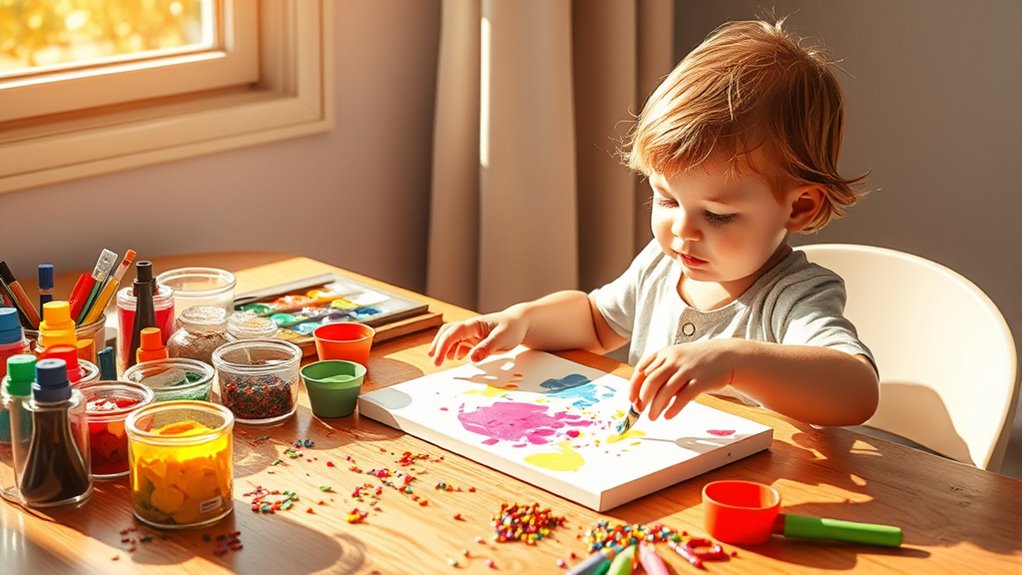
While many parents may not realize it, engaging in arts and crafts is crucial for your toddler’s cognitive development. These activities enhance problem-solving skills by encouraging decision-making and critical thinking during creative projects. Furthermore, continuous learning through creative exploration can set the stage for lifelong curiosity and innovation. Engaging in these creative activities can also mirror the importance of creating an interior design mood board as they both require thoughtful organization and a blend of different elements to achieve a desired outcome.
When your child paints or sculpts, they evaluate materials and techniques, fostering a love for creativity and self-expression. Arts and crafts also improve fine motor skills, enhancing hand-eye coordination and dexterity as they manipulate supplies like playdough and crayons. This development lays a foundation for writing and using delicate instruments, which is essential during the critical periods of early childhood. Engaging in creative play with Waldorf toys can further enrich these experiences by promoting imaginative scenarios and role-play.
In addition, art activities support literacy and math skills by promoting listening, following instructions, and understanding concepts such as counting and measuring. Furthermore, early exposure to STEM education can complement artistic endeavors by enhancing critical thinking and creativity.
Emotional Benefits of Creative Expression
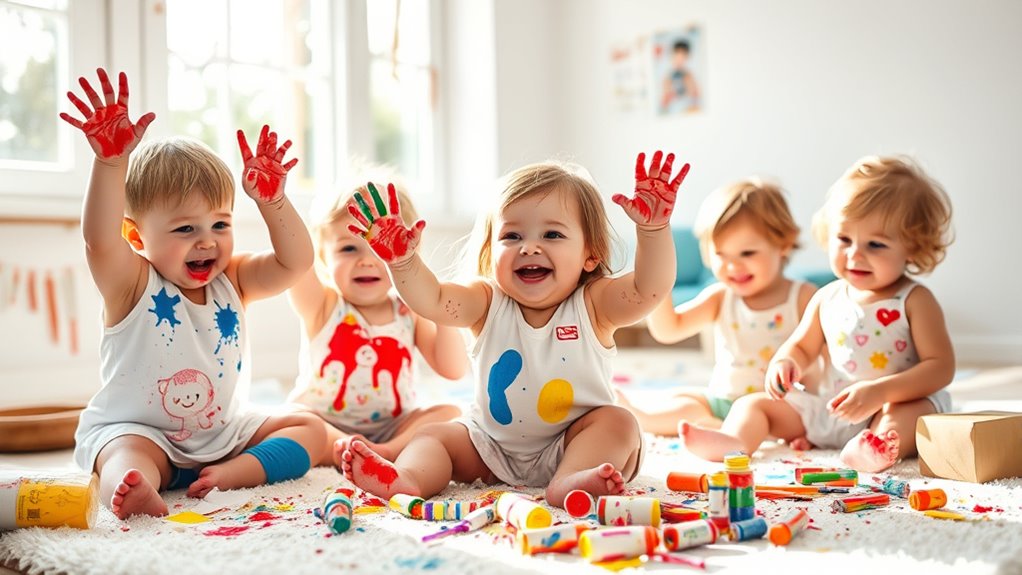
Engaging in arts and crafts not only supports cognitive development but also greatly benefits your toddler’s emotional well-being.
Through art, your child can express feelings they mightn’t yet have the words for, processing complex emotions like joy, sadness, or anger. This creative outlet helps them regulate their emotions, manage stress, and build resilience. As they complete art projects, they gain confidence and a sense of accomplishment that boosts their self-esteem. Additionally, creative expression has been shown to foster mindfulness techniques that enhance present-moment awareness, further supporting emotional regulation. Participating in these activities fosters empathy and self-awareness, essential skills for social development. Furthermore, engaging in creative expression can enhance strong communication skills, which are crucial for their future relationships. Engaging in music-making activities can also promote emotional well-being, allowing children to explore their feelings in a supportive environment. Moreover, curiosity can lead to significant brain changes that enhance learning, enriching your child’s creative journey.
Enhancing Fine Motor Skills Through Art
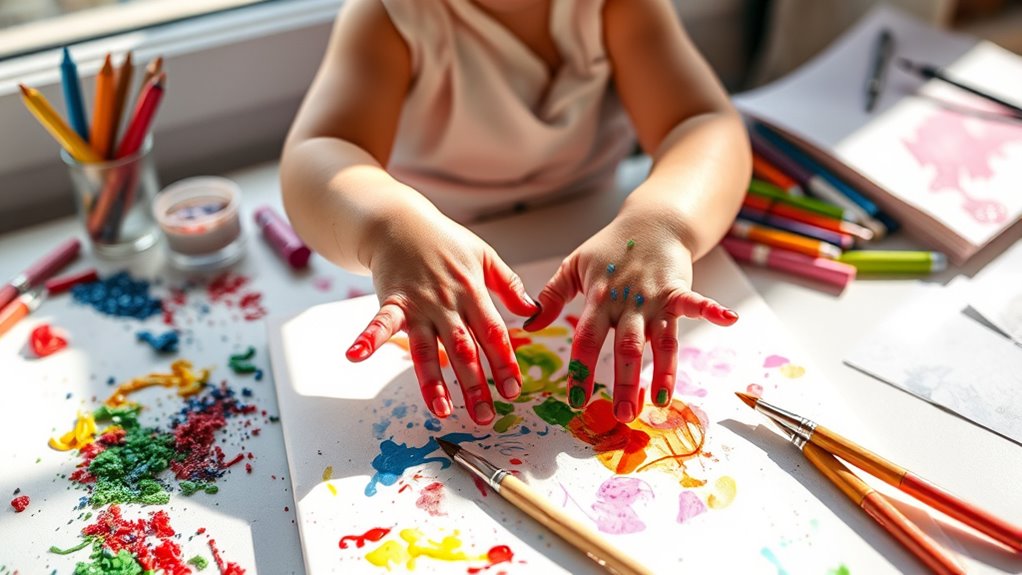
Art activities provide a wonderful opportunity for toddlers to enhance their fine motor skills as they explore various materials and techniques. Engaging in tasks like drawing, painting, and cutting strengthens hand muscles and improves dexterity. For instance, finger painting encourages specific hand movements, building strength while allowing your child to express themselves. Activities like threading beads or crafting with playdough refine grasping and guiding skills. Using tools like droppers or scissors promotes hand-eye coordination. Additionally, routine health checks for signs of illness, such as unusual behaviors, can be a part of creative play, fostering awareness of their own bodies. Even simple tasks, like peeling stickers or manipulating tongs, can greatly boost fine motor development. Incorporating Montessori toys into art activities can further enrich the learning experience by promoting hands-on exploration and creativity. Engaging in creative tasks can also enhance color accuracy, which is important for visual perception as children learn to differentiate between various shades and hues. Moreover, using educational toys can make these art activities even more engaging and beneficial for their growth. Furthermore, incorporating sensory toys allows children to experience new textures and sensations, enhancing their creativity and cognitive development.
Nurturing Imagination and Creativity
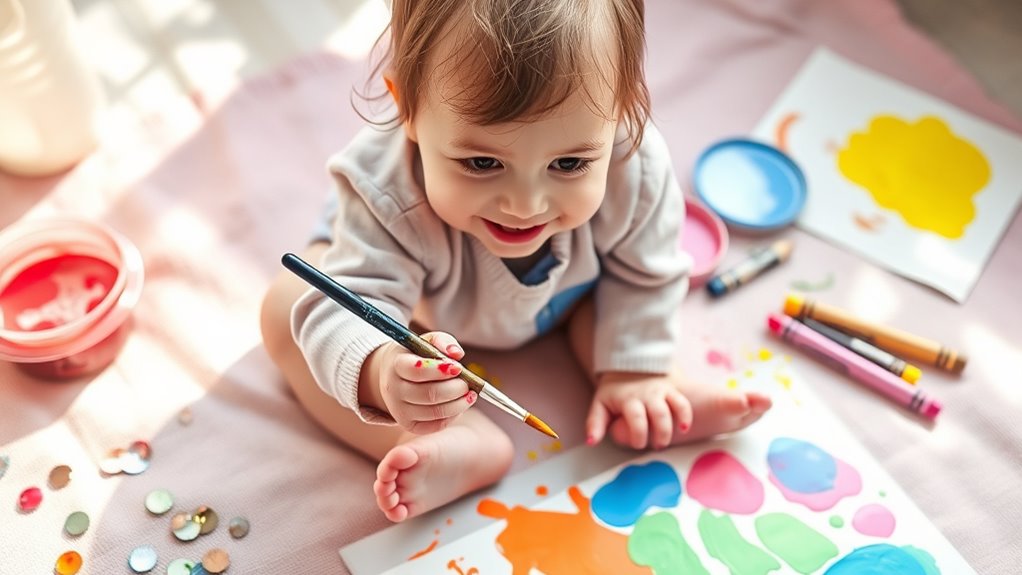
Nurturing imagination and creativity in toddlers is essential for their overall development. Engage your child in storytelling and role play, allowing them to explore different scenarios and enhance their social skills. Creative practice can significantly impact their ability to think outside the box. Large indoor plants, like the Areca Palm, can also inspire creativity by bringing nature indoors and providing a vibrant atmosphere.
Introduce new experiences through outings that broaden their perspectives. Offer open-ended toys like blocks and dolls to encourage imaginative play. Unstructured playtime lets them express their creativity independently.
Incorporate art supplies and recycled materials for creative experimentation. Nature walks can inspire fresh ideas, while music and movement foster unique artistic expression. Additionally, creating a play space that encourages self-fulfillment can significantly enhance their imaginative journey. Providing a clean environment can also help maintain focus, similar to how regular air purifier maintenance improves air quality.
Remember to participate in their play, encourage mistakes as learning opportunities, and ask open-ended questions. Creating a play space and limiting screen time promotes active engagement in their imaginative journey.
Engaging Arts and Crafts Activities for Toddlers
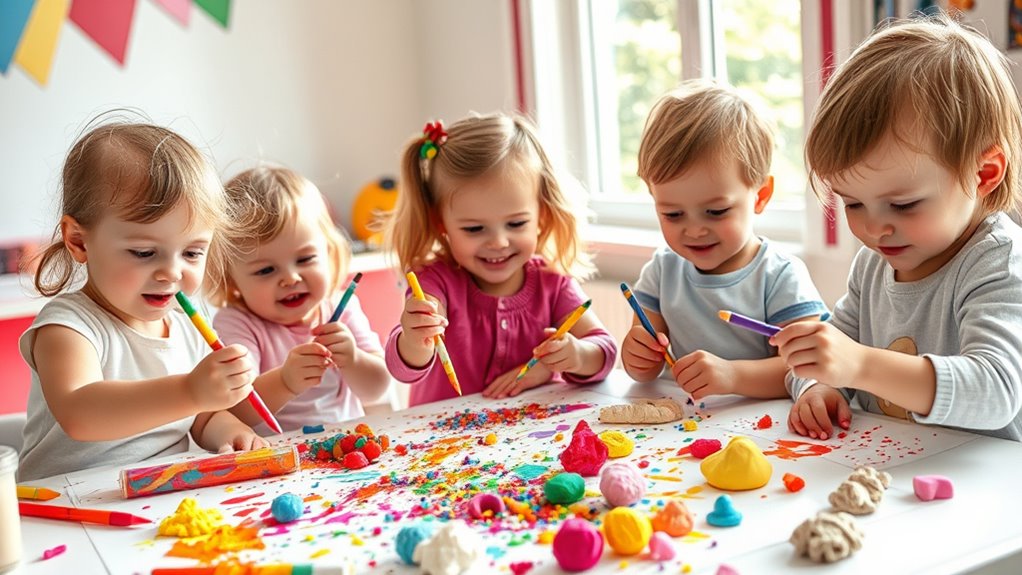
While toddlers explore the world around them, engaging in arts and crafts offers an exciting way to develop their creativity and fine motor skills. Simple activities like finger painting or homemade paint allow your child to experiment with colors and textures, enhancing cognitive skills. Foraging behaviors can also inspire creative projects, such as nature-themed crafts that connect art with the natural world. To ensure the longevity of their artistic creations, consider using durable materials that can withstand the wear and tear of play.
You can create a beautiful leaf collage with contact paper, fostering their artistic expression without the mess. Encourage their dexterity by introducing sewing with basic stitching or stringing beads.
For sensory exploration, try a noodle sensory bin or marbleized paper for fun color mixing. These projects aren’t only accessible but also provide a fantastic opportunity for you to participate, making the creative process feel inviting and achievable for your little one. Additionally, consider introducing simple origami techniques such as crafting a paper boat, which can further enhance their fine motor skills while being a fun activity.
The Role of Arts and Crafts in Social Development
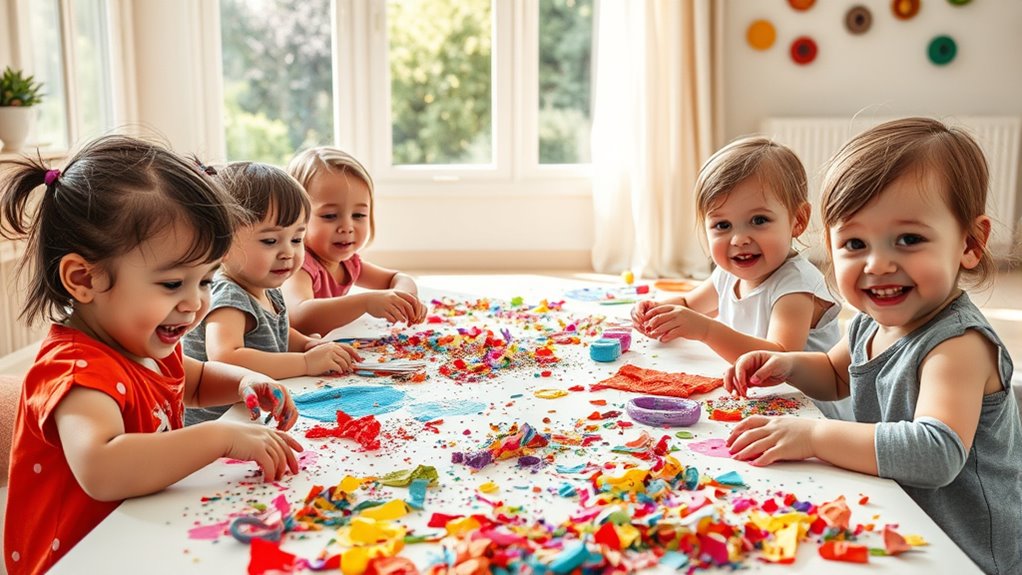
Engaging in arts and crafts not only sparks creativity but also plays a significant role in toddlers’ social development.
When you involve your little ones in collaborative projects, they learn teamwork and build friendships. Sharing materials and ideas fosters a sense of community, while exploring diverse perspectives enhances their understanding of others.
Art activities also promote verbal and nonverbal communication, helping toddlers express their feelings and thoughts. They navigate social dynamics as they collaborate, developing essential social skills like sharing and cooperation.
Through these creative experiences, toddlers gain empathy and emotional intelligence, learning to appreciate individuality and manage complex emotions.
Ultimately, arts and crafts create a safe space for meaningful social interactions, laying a solid foundation for future relationships.
Encouraging Independent Thinking and Problem Solving
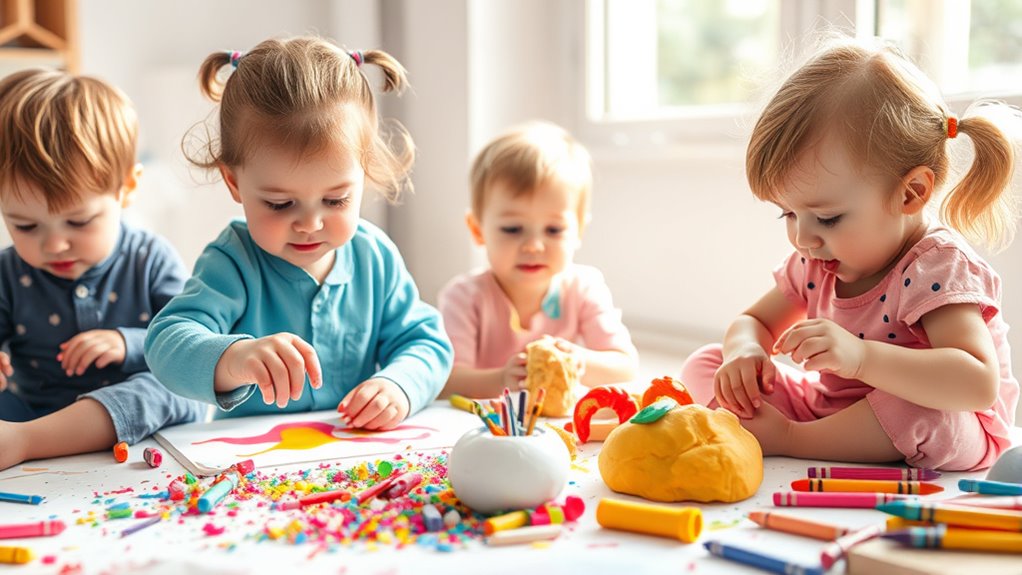
When toddlers immerse themselves in arts and crafts, they naturally develop independent thinking and problem-solving skills. These activities foster imagination by allowing your child to explore their ideas freely.
Unstructured playtime encourages them to create without limits, enhancing their ability to think independently. Open-ended projects give toddlers the chance to devise their own solutions, while access to various materials promotes exploration and experimentation.
As they engage in trial and error, they learn persistence and resilience, understanding that mistakes are part of the process.
Tips for Successful Arts and Crafts Sessions With Toddlers
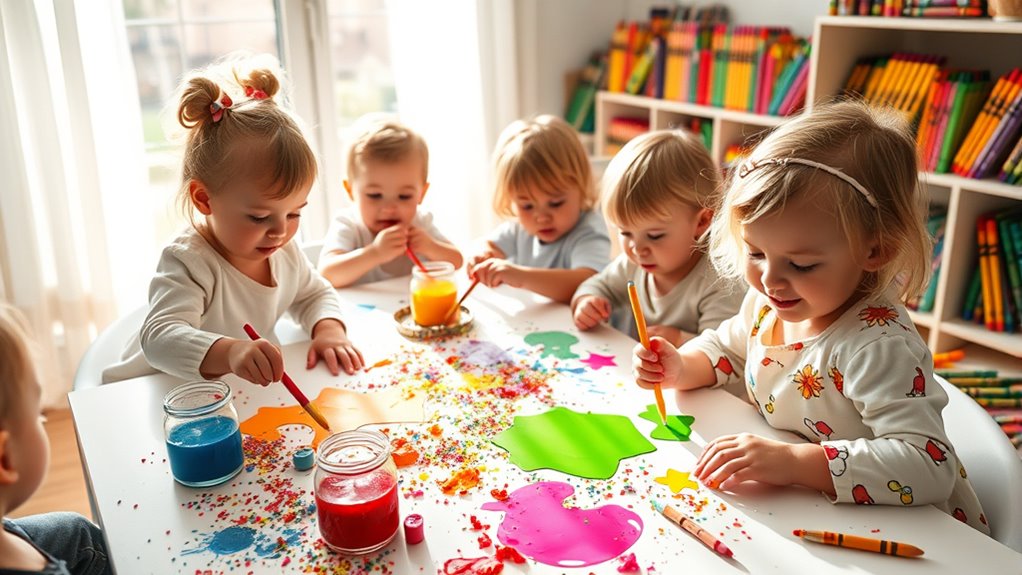
Creating successful arts and crafts sessions with toddlers requires thoughtful preparation and an inviting environment. Use safe, non-toxic supplies and set up a designated creative space at home. Open shelving makes materials easily accessible, and displaying their artwork boosts confidence.
Prepare for messiness by having cleanup supplies at hand, and consider using smocks to protect clothing. Establish clear rules and limit supplies to prevent overwhelm. Engage toddlers in activities that enhance fine motor skills, like painting or threading beads.
Foster creativity by allowing exploration and encouraging unstructured play. Maintain a positive atmosphere by providing immediate feedback and emphasizing the process over the final product.
Participate alongside them to model creativity and focus on discovery.
Frequently Asked Questions
What Materials Are Safe for Toddlers to Use in Arts and Crafts?
When choosing materials for toddlers’ arts and crafts, opt for non-toxic crayons, vegetable-based finger paints, and natural play dough to guarantee safety.
You can also use washable markers and recycled materials like cardboard and fabric scraps.
Incorporating natural items, such as leaves and flowers, enhances creativity while promoting an understanding of nature.
Always supervise your child during these activities and store supplies safely to prevent any accidents.
How Can I Clean up After a Messy Craft Session?
Cleaning up after a messy craft session can feel like chasing a whirlwind, but it doesn’t have to be intimidating.
Start by tackling spills right away, using water and cloths to wipe the chaos. Gather supplies into labeled bins, making organization a breeze.
Get the kids involved—turn cleanup into a fun game! With a little music and teamwork, you’ll transform the aftermath into a tidy space in no time.
At What Age Can Toddlers Start Doing Arts and Crafts?
Toddlers can start engaging in arts and crafts around 12 to 18 months.
At this age, you’ll notice them developing fine motor skills, which are essential for these activities. You can introduce simple tasks like finger painting or coloring with washable crayons.
As they grow, you can gradually explore more complex activities, ensuring they match your child’s abilities and interests.
This way, you’ll keep their creativity thriving while supporting their development.
How Long Should Arts and Crafts Sessions Last for Toddlers?
When planning arts and crafts sessions for toddlers, aim for sessions lasting around 10 to 20 minutes.
Since their attention spans are short, keeping activities brief helps maintain their interest. You’ll notice they thrive on flexibility and exploration, so allow for spontaneous creativity.
Pay attention to their cues; if they seem restless, it’s time to wrap up. Short, engaging sessions prevent overwhelm and foster a love for creative activities.
Can Arts and Crafts Be Done Outdoors?
Absolutely, you can do arts and crafts outdoors!
In fact, outdoor settings provide a fantastic space for creativity to flourish. You can use natural materials like leaves and twigs to enhance your projects.
Plus, the open air allows for messy activities without the worry of indoor cleanup. Engaging with nature while creating art not only adds excitement but also helps you connect with the environment in a fun and meaningful way.
Conclusion
As you watch your toddler splash paint across the canvas, their giggles fill the air like music, and you realize the magic of creativity unfolding before your eyes. Each colorful stroke nurtures their imagination, fosters fine motor skills, and builds friendships through shared laughter. Embrace these moments, and encourage their artistic journey. With every craft session, you’re not just creating art; you’re shaping a world where their dreams can soar like kites in a clear blue sky.


